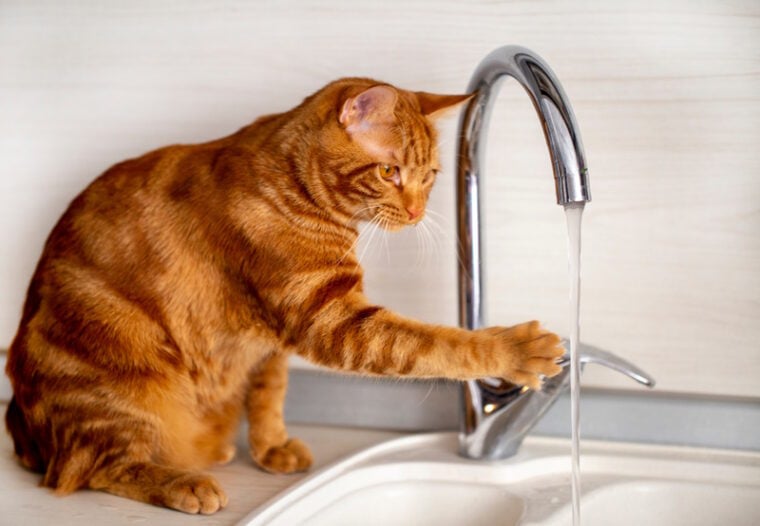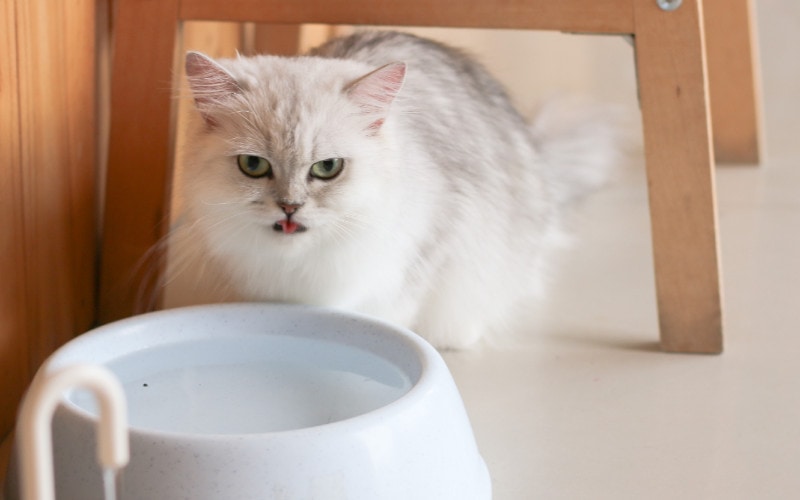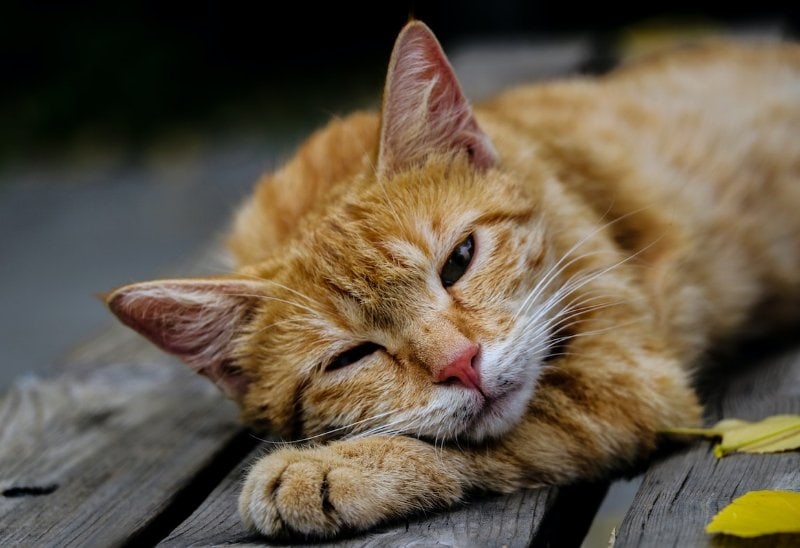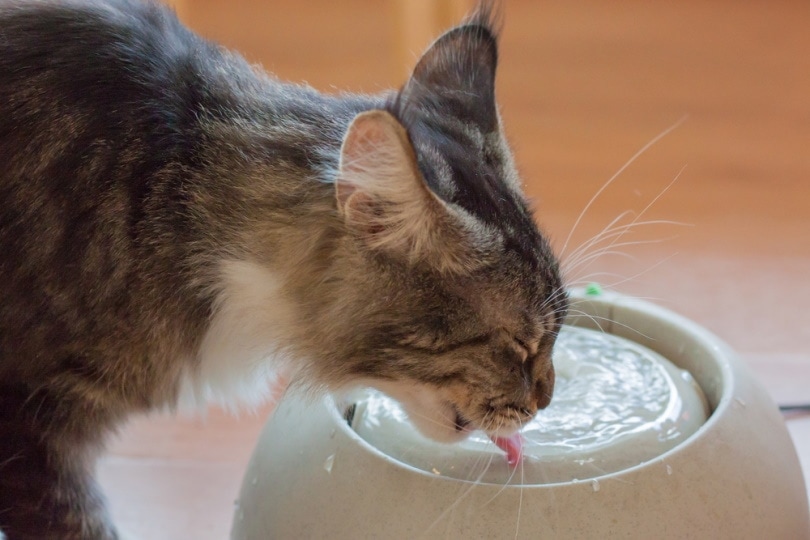
If you are a cat owner, you will know that they should always have access to clean, fresh water. In nature, animals get their water from rivers, lakes, streams, puddles, watering holes, or ponds, but when it comes to our pets, tap water is the most convenient source for us to use, but can cats drink tap water?
The answer is: Yes. If the tap water is safe for us, then it is also safe for our cats. This generally means that cats can drink tap water, but in areas or situations where the water is suitable only for cleaning, and not for consumption (non-potable), then it is also not safe for your cat.
Which Tap Water is Safe For Cats?
The safety of tap water is regularly monitored and treated to guarantee that it is fit for consumption, so giving your cat tap water is perfectly safe.
You may already be aware that there are typically two kinds of tap water: hard and soft water. Let’s take a look at what this means for you and your cat.
Hard and Soft Water
Hard and soft water refers to the concentrations of minerals in the water; the harder the water, the more minerals are in it. Hard water is higher in calcium (Ca), magnesium (Mg), and iron (Fe). This is basically down to geography and geology – water that passes through more porous rock, like limestone, will pick up more minerals.
Soft water refers either to:

Which Is Better – Hard or Soft?
Hard water has the advantage of providing minerals (calcium, magnesium, iron) which are highly beneficial to both human and feline health, particularly for heart and bones. The downside is that the minerals leave deposits on skin and hair, which can lead to skin irritation and poor hair condition, and limescale accumulation on appliances. Many people (and potentially cats) do not enjoy the taste of hard water.
Soft water is great for clothes, skin, hair and appliances, but offers very little in the way of health benefits. The higher sodium content of soft water has the potential to be a problem for cats (and humans) on low sodium diets, but water testing generally ensures this is not the case. The taste of soft water is generally preferred over that of hard water.
Neither hard or soft water are harmful for your cat. There are more potential health benefits from drinking hard water, but cats will likely prefer the taste of soft, or softened, water. The question has been raised regarding a link between hard water and the incidence of urinary crystals in cats, but there is currently no scientific evidence to support this hypothesis.
The choice of whether you have soft or hard water will depend on where you live, and whether you have a water softener installed. You can soften hard water, but you cannot install a water hardener.
Are There Any Risks of Giving Tap Water?
There is always an inherent risk of physical, biological, chemical or radiological contamination of tap water, but in developed countries like the United States, this risk is low. Things like natural disasters, particularly flooding, can lead to water contamination, which is why bottled water becomes a valuable commodity at such times.
The only other time that tap water is considered unsafe for your cat is if it is a non-potable water source. Non-potable water can be in a number of forms, including stormwater, untreated groundwater, recycled water, or greywater. This type of water is useful for irrigation, clothes washing, toilet flushing, cleaning equipment or cars, but should not be used for drinking or food preparation, and should not be given to pets.

What Is the Best Water To Give Your Cat?
Tap water! From a safety, convenience, economical, and ecological standpoint, tap water is the best option for your cat, and here’s why:

The Importance of Keeping Your Cat Hydrated
As we know, water is essential to all life, so we must ensure our cats are always getting enough. Felines aren’t always big drinkers, but there are often perfectly normal reasons for this. On average, cats need around 8-10 fl. oz per 10 lbs of body weight, but this can be consumed both as water or as moisture in food.
Factors that will impact a cat’s daily water needs include weather, activity levels, health, and diet. Cats eating predominantly wet food will get around 80% of their daily moisture requirement from their food, so it is not unusual for them to rarely be seen at a water bowl. On the flipside, cats that are fed a completely dry food diet should be drinking water regularly.
By and large, cats will drink as much or as little water as their body needs, but it is important to familiarize yourself with what is normal for them, so it is easier to spot when things aren’t right.
Cats can survive up to 3-4 days without water, but they will start to suffer the effects of dehydration within 24 hours; less in particularly hot conditions. Signs that your cat may be becoming dehydrated include:
If you see ANY of these signs, your cat needs to be seen by a vet.

How To Encourage Your Cat To Drink Water
If you are worried that your cat doesn’t drink enough water, or they appear to not like drinking from their bowl, here are a few tips to ensure your cat’s water supply is as appealing as possible:

Conclusion
The great news is that, unless it isn’t safe for us, tap water is perfectly safe for your cat. There may be times when you need to switch to bottled or filtered water, but these would be few and far between. In terms of safety, both hard and soft water are safe, but you may find that cats prefer their water to be filtered if your water is particularly hard. Cat water fountains are great in this situation, but do be aware that if you have hard water, the fountains will often get limescale.
There are a number of factors that will influence how much water your cat needs, as well as how much they will actually drink. If you notice that your cat is drinking a lot more than normal, or you are worried that they are showing signs of dehydration, book an appointment with your vet.
See Also:
- Why Does My Cat Drink Dirty Water? 5 Common Reasons
- Can Cats Drink Tuna Water? Vet-Approved Health & Nutrition Guidelines
Featured Image Credit: NadyGinzburg, Shutterstock






